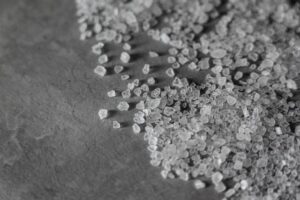Physical Address
23,24,25 & 26, 2nd Floor, Software Technology Park India, Opp: Garware Stadium,MIDC, Chikalthana, Aurangabad, Maharashtra – 431001 India
Physical Address
23,24,25 & 26, 2nd Floor, Software Technology Park India, Opp: Garware Stadium,MIDC, Chikalthana, Aurangabad, Maharashtra – 431001 India

A study published on Tuesday has revealed that all salt and sugar brands in India, whether large or small, packaged or unpackaged, contain microplastics. The study, titled “Microplastics in Salt and Sugar,” was conducted by the environmental research organization Toxics Link.
Microplastics, defined as plastic particles measuring less than 5 millimeters, originate from various sources including industrial waste, textiles, synthetic car tires, personal care products, and more.
The research tested a variety of salt types—table salt, rock salt, sea salt, and local raw salt—as well as five types of sugar from both online and local markets. The findings confirmed the presence of microplastics in all samples, including fibers, pellets, films, and fragments, ranging in size from 0.1 mm to 5 mm.
Iodised salt had the highest concentration of microplastics, with 89.15 pieces per kilogram of dry weight, predominantly in the form of multi-colored thin fibers and films. Conversely, organic rock salt exhibited the lowest concentration at 6.70 pieces per kilogram.
Ravi Agarwal, founder-director of Toxics Link, emphasized the importance of the study in contributing to the scientific understanding of microplastics. “Our objective was to enhance the global scientific database on microplastics to support concrete actions under the global plastic treaty,” Agarwal stated. “We also hope to stimulate policy responses and technological innovations to mitigate microplastic exposure risks.”
Satish Sinha, associate director at Toxics Link, expressed concern over the findings. “The substantial presence of microplastics in all tested samples underscores the need for urgent, thorough research into their long-term health effects on humans.”
The study’s results highlight an urgent need for comprehensive research and policy measures to address the pervasive issue of microplastics in everyday consumables.
Microplastics are being found in sugar samples, with concentrations ranging from 11.85 to 68.25 pieces per kilogram. Notably, non-organic sugar tends to have the highest levels of microplastics. These tiny particles pose significant risks, as they can enter the human body through food, water, and air, potentially affecting organs like the lungs and heart, and even contaminating breast milk and unborn babies.
Given that the average Indian consumes about 10.98 grams of salt and approximately 10 teaspoons of sugar daily—exceeding the World Health Organization’s recommended limits—the presence of microplastics in these commonly consumed products raises serious health concerns.
A Growing Concern for Health and Environment
Waseda University of Japan had noted in an official statement after they published a study that research indicates that microplastics are ingested or inhaled by both humans and animals and have been discovered in multiple organs.
The university’s statement also mentioned that ten million tons of these plastic particles find their way into the ocean, released through ocean spray, and subsequently enter the atmosphere. This implies that microplastics may have become an integral component of clouds, contaminating nearly every facet of our food and drink through ‘plastic rainfall.
Scientists have earlier found microplastics in human blood, lungs and infant feces. Emerging evidence has established connections between microplastics and a range of health consequences, encompassing impacts on heart and lung health and extensive environmental degradation.
Read more here.
How do microplastics get accumulated in Indian sea salts?
Ocean ecosystems are gravely concerned about plastic contamination. Although it is difficult to assess the amount of plastic dumped into the ocean with certainty, estimates show that at least 14 million tonnes of plastic enter the ocean annually. In the next two decades, the amount of plastic is expected to significantly increase if nothing is done.
The discovery of microplastics (plastic particles smaller than 5 mm) in a variety of marine animals, including fish, mussels, and crustaceans, has brought the pervasiveness of plastic contamination in the marine environment into sharp light in recent years.
Despite being thought of as nearly indestructible, plastic does fragment in the environment when exposed to ultraviolet light and outside pressures, leading to mechanical and biological degradation and the creation of smaller plastic particles.
Read more here.
How does plastic impact climate change?
Plastic production, dependent on fossil fuels, significantly contributes to climate change. Throughout the plastic product lifecycle, greenhouse gas (GHG) emissions accelerate global warming. Each phase of plastic production, from raw material extraction and manufacturing to waste management and environmental release, emits GHGs.
It’s predicted that by 2050, plastic production alone could consume 13% of the planet’s carbon budget, depleting Earth’s carbon reserves due to global GHG emissions. Poor plastic waste management, leading to accumulation in natural areas like riverbanks and coastlines, exacerbates GHG emissions.
Microplastics in the ocean hinder carbon sequestration by delaying GHG release from plastics. Estimated plastic-related GHG emissions from production to disposal could reach 1.34 gigatons per year by 2030 and 2.8 gigatons per year by 2050. This substantial carbon consumption threatens the international community’s ability to limit global temperature increases to 1.5°C or 2°C by 2100, endangering the remaining carbon budgets.
With inputs from Aayushi Sharma
References:
Microplastics in Salt and Sugar
The Silent Threat: Microplastics and their Impact on Climate Change
How are micro plastics a concern for sea salts in India?
Plastic Cloud: New Study Analyzes Airborne Microplastics in Clouds
Microplastics in Clouds might be playing a role in Climate Change
https://www.sciencedirect.com/science/article/pii/S0160412022001258
https://pubs.acs.org/doi/abs/10.1021/acs.estlett.1c00559
Photo by Castorly https://www.pexels.com/photo/macro-photography-of-crystal-salt-3693293/
Photo by monicore
https://www.pexels.com/photo/close-up-photo-of-himalayan-salt-2624400